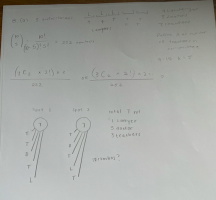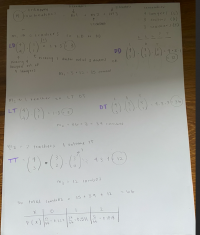Hi there,
I'm having trouble with this question below:
A special committee of five professionals is formed from a group of four lawyers, three doctors and three teachers. At least three lawyers are needed in the special committee. Define X as the number of teachers in the special committee. Construct the probability distribution of the random variable X.
I get initially that n=10 and k=5 as there are 10 people in total and 5 spots. But 3 of the spots are occupied by 3 lawyers therefore the n and k change to, n=7 and k=2.
From here I am lost.
Do I use a combination or a permutation? and is it 7C2 = 21 or 7P2 = 42. Also, because I am looking for the random variable X, am I just looking at the combinations of teachers so is that 3P2?
I've attached my work below,
Thanks in advance
I'm having trouble with this question below:
A special committee of five professionals is formed from a group of four lawyers, three doctors and three teachers. At least three lawyers are needed in the special committee. Define X as the number of teachers in the special committee. Construct the probability distribution of the random variable X.
I get initially that n=10 and k=5 as there are 10 people in total and 5 spots. But 3 of the spots are occupied by 3 lawyers therefore the n and k change to, n=7 and k=2.
From here I am lost.
Do I use a combination or a permutation? and is it 7C2 = 21 or 7P2 = 42. Also, because I am looking for the random variable X, am I just looking at the combinations of teachers so is that 3P2?
I've attached my work below,
Thanks in advance


